Story – Chris Hector & Photos – Roz Neave
It is so interesting watching Jean Bemelmans work the stallion, Lancerio. Often we get the idea that collection is the icing on the cake, the fancy bit at the end of the lesson, not so with Jean. Collection is an integral part of the gymnastic, or putting the horse in balance and self carriage. In – Out – In – Out, and the out is a relaxing deep long flowing outline…
“As long as they are ready to do this after exercise, it means they are good, there is no tension, nothing. He cannot be more supple than he is today, he is good – he can go now for a walk in the wood…”
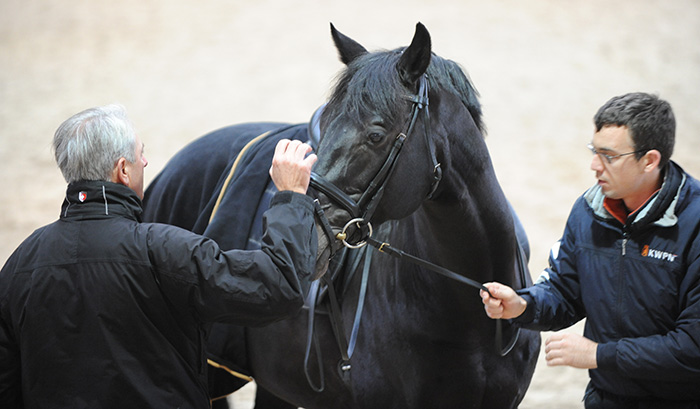
Which is great for us, because it means Jean joins us for a coffee, and a chat in the gallery as the groom takes the lucky stallion on his little outing. This care for the horse’s mental well-being is core to Jean’s training:
“The most important point is the character. If they are not willing to work with you, then they can have the best quality in the world, but it won’t work. If you go to the Olympic Games, you can see fifty horses that are qualified, all these fifty horses can do the Grand Prix, but the winner is the one who does it at the moment he is asked to do it. He wins with his talent, but he also wins with his brain – this is so very important, the way you live with your horses every day, that you have the horses on your side. Horses must be happy horses, they have to be willing to work for you, you cannot make them work. That’s why in your daily work you must think hard about your horse – how is he feeling? Is he happy? He has to be obedient, but he cannot be squashed, you have to leave him with his personality. Sometimes horses with not such good qualities, they can win if they want to do the job.”
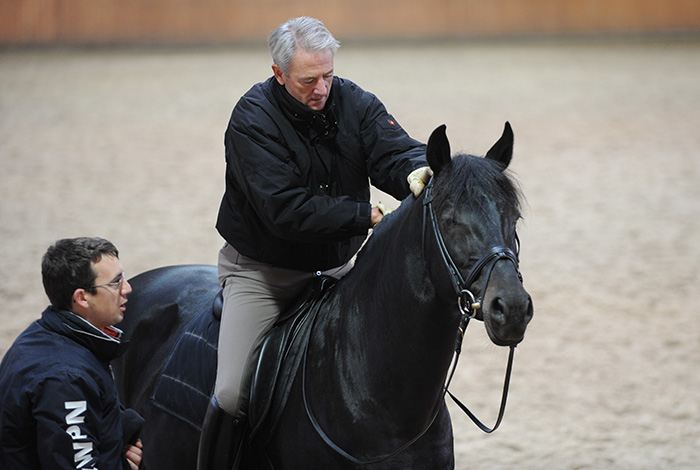
next Jean tells us about his assistant
Jean may have finished for the day, but his assistant, Jordi Domingo is cruising around the arena on his wonderful Dutch bred son of Ferro, Prestige. The horse truly is sensational, all the work looks so easy and effortless. It’s really something of a surprise, because when we last saw the pair in action riding for Spain at the Euros in Windsor, the horse was very unimpressive. Jean is still trying to work out what went wrong:
“Jordi has been working with me for three years, so at the end, he knows. Just one look, and he knows what I want. You understand each other without speaking a lot. I think that at the moment, we have a good system with Prestige. We lost it a little bit in the summer, for whatever reason, we had it before and now we are getting it back again, and the horse feels happy. If we can find the form again then the future is very positive, because the horse can easily go over 70%.”
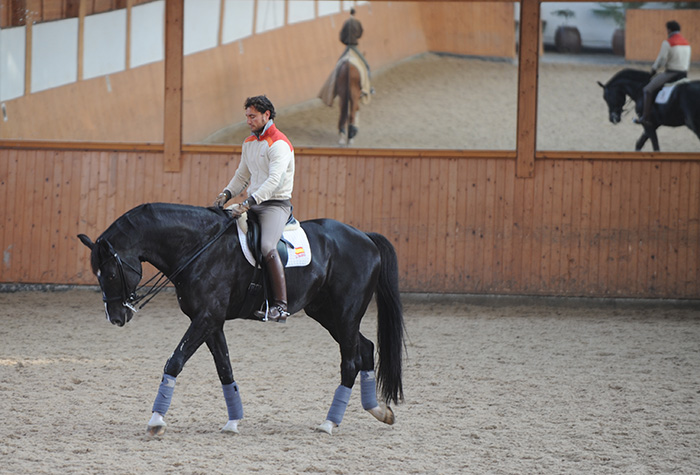
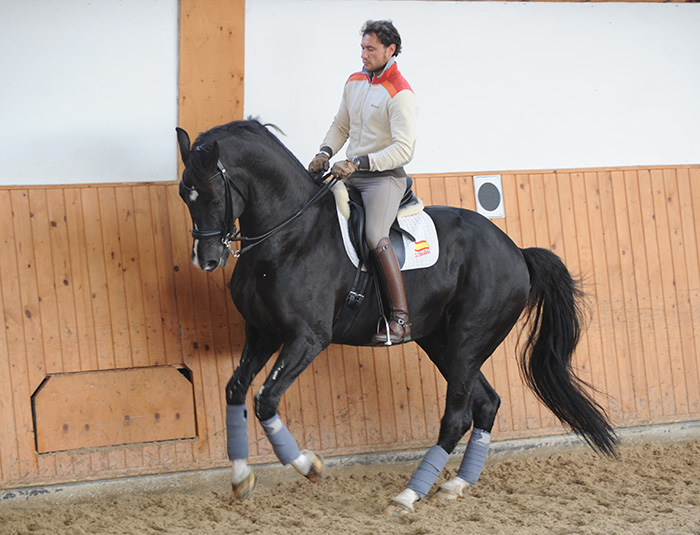
You said you didn’t know at the European Championships in Windsor whether you had worked Prestige too much, too little…
“I don’t know. He was very good at Wiesbaden and then he went to a show alone, in Cannes. Cannes was a lot of people and it went a little bit wrong, and then the next show was Aachen. In Aachen it was one good day, one bad day, then you can lose a little bit of confidence, horse and rider. These things happen…”
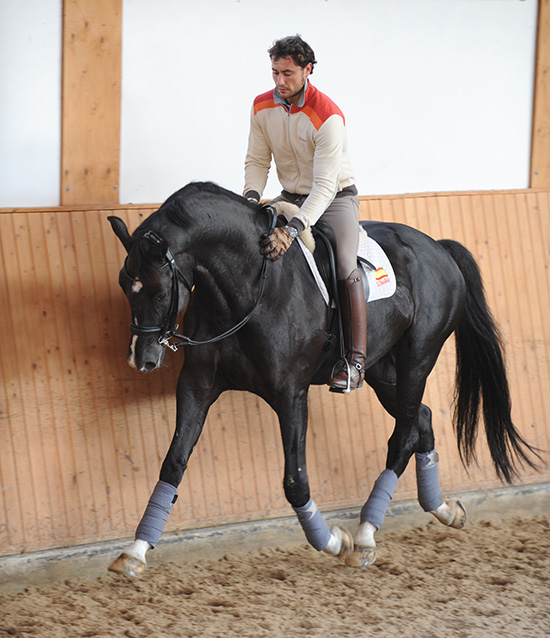
Is it different training Spanish and Iberic horses to European Warmbloods?
“There is not that much of a difference, the difference is a little bit the riders and the system of training they follow. I think if you get a three-year-old horse and you start riding that horse, then you can make him Grand Prix without any problem if you don’t make any mistakes. The biggest problem is not to make a mistake, and to go step-by-step, this is why in Germany I think we have a perfect system for three-year-old and four-year-olds. I know many years ago, you could go into a Grand Prix with a six year-old-horse. Bert Rutten took Ampère to the Los Angeles Olympic Games when he was six years old. It was decided then they can only go in S level classes when they are seven, and I think this is a good rule. If you go step-by-step and take time, you can do a good job, this was a little bit of the problem in Spain, they just take a horse and they don’t know the gymnastics they have to do before they go to the exercises. The horses need to be able to control their bodies first…”
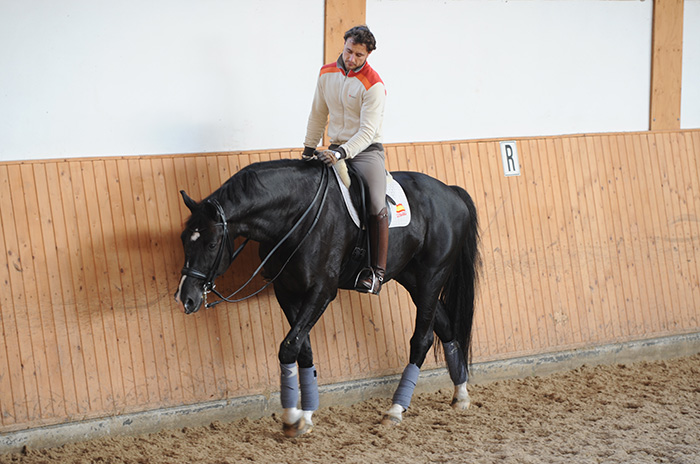
“Why do we do this low and deep and stretching? Because a horse if it runs in the field, cannot run with body alone – it needs the neck to balance itself. If you fix the neck, then there are many exercises that you cannot do. The horse needs his neck. It is very important at that at the beginning you don’t go too quick with the exercises because the horse learns the exercises, but they have to learn also to stay in balance, to collect, to go a little longer, to have a perfect balance in what they are doing, and then it is much easier for them. And this is the same for Iberian horses as for Warmbloods or whatever, it is just that we do this preparation in Germany and they didn’t do it in Spain in the past. Now it changes and starts to be a little bit more in the scale of education, but it is important to go there step by step.”
“On the other side what impressed me was that thirty years ago, I went to competition and then the Germans came and maybe a little bit the Dutch, and then there was a big difference to all the others; we were controlling the world. Now with video, with computers, inter-net, people know more about dressage and now it is a little big more difficult for the Germans because the knowledge we have in Germany is sold all over the world. So in deepest Australia, they know about the basics, and that is why they all get better and better.”

People often say the Iberian horse has a natural ability for piaffe and passage and pirouette. You’ve trained a lot of them, is this your experience?
“They do have this ability. In Spain you have bull-fighting and they breed horses specially for bull-fighting, and these horses have to be quick, these horses have to be very under control, because if you go into a bull-fighting arena, and you can’t control your horse, you are dead. I see sometimes that these horses have a special spirit, they grow up in the field with the bulls, with the cows… I was talking with a guy who trains eagles to hunt, and this man told me, ‘if you breed an eagle and then teach him to hunt, there is always a difference to the eagle that you catch in the wild – the wild one is always better than the one you breed at home.'”
Fuego – so intelligent, so clever
“These Spanish horses grow up in big herd, they know the rankings between the bulls, and it gives these horses a little bit more life – for example Fuego, he is so intelligent, he is so clever – because he was between the bulls, between the other stallions, and this I like with the Spanish horses, they are awake. And if they understand something, they will do it.
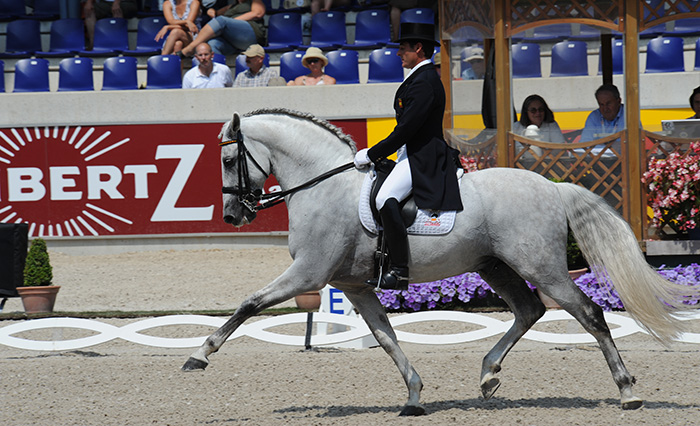
They have a very good character, they are good to work with. What they miss a little bit, is sometimes in the walk and trot they can be better, but you can find it. Look at Invasor, he was maybe not the best trotter in the world, he could do a nice trot, but Evento, just before him, was a top trotter – like a Warmblood, if you could paint him black, he would be a Hanoverian. The good thing with Evento, was the brain of this horse. We went to Rome in the WEG, and the horse was sick so we could only walk him, walk him. Then our vet said, it is a big risk but okay. So we did no training with this horse, and he scored 68 / 69! No horse in the world will do this – you have to prepare him, prepare him – this one, he knew the job.”
Evento – paint him black and he looks like a Warmblood!
Watching you work today, it’s another level of collection from most places, the collection comes in and out, it is not at the end of the working session, it seems integral to everything you do…
“I am a fan of high collection because I always think you have to ‘see’ the collection. To see the collection means – especially in the canter – that at a certain point they start to sit a little bit. This is collection and this is also a gymnastic, this is putting the weight on the hindquarters, carry all the horse on the hindquarters and then go out. After the walk period, I go very quickly to this work, but in a different way. In the beginning, I do it on quite a long rein, with a longer neck, so that the horse can be open in this work. Later on I put him more and more in an uphill position, with more impulsion.”
People talk about you can’t use two aids – hand and leg – together, but watching you work, it seems you must ride into a restraining hand or you can’t teach dressage…
“You have to feel the hind leg in your hand. The best example is once I was sitting in a carriage, then you feel the meaning of contact, because if this horse goes behind the bit, you go no-where. You drive the horse, with the contact, he takes the bit, and with this bit you go left, you go right. This I always have in my mind, if you are riding, even on the low and deep, you need a contact, if I don’t have contact – where do I go? I can do a quick turn but I cannot do a smooth turn.”
“First I learnt to ride Grand Prix, then I learnt the theory! (Lots of laughter)
Theory can get in the way?
“Sometimes yes, it can. If you read all the different books and all the different opinions, then you get confused. The horse tells you what to do. I was taught by an old school master, Mr Robert Schmidtke. He was with Bubi Gunther, Hans Pollay, after the war they were all together in Hanover in the cavalry. They learned all together – Bubi Gunther, Willi Schultheis, but at the end everyone developed a little bit their own way, because Willi Schultheis did it a little different from Robert Schmidtke. Bubi Gunther too, everybody adapted a little bit to his body, how can I use my talent the best? Schmidtke was a small man, and I think he had to ride the horses nice and light because he was not so strong. Schultheis was stronger, maybe he could get the horses up a little quicker.”
“Forty years ago, I went to Mr Schmidtke, and he was riding like I am riding today. I learned this. I didn’t invent a new way of riding. From three to five years old, you could only go low and deep with the horses, they have to use the neck to balance themselves, and only this. Suddenly, they are five and from five to seven, they learn everything very quick. If their body is not ready and you start to do the exercises too early, then you make mistakes and get in trouble, but if you do it in a good way and you feel, oh now the horse is ready, and you know the horse is in balance, know he can canter a little bit on the spot, know he can go forward, okay, then you can begin with flying changes very easy. If they know one flying change they can do three tempi, four tempi, one tempi – it’s no problem. The problem is if they are not ready. If they are not in balance.”
For Jordi it has been quite a move – from Spain, to Holland to Germany, but he is determined to make it in the world of competitive dressage:
“I started riding in Spain when I was little. All my family had horses. I was more into bull-fighting in the beginning, my first trainer was a bull-fighter when I was very young. Then my parents offered me the opportunity to ride dressage, I tried it, liked it…”

“I started in Spain, and moved the Holland when I was 18. I was riding and training in Holland for eight years, then two years ago I moved to Germany. I had been working with Jean before that, but I have been based with him for two years.”
“I got Prestige when he was five. He was a stallion then, and he was quite a difficult horse but I saw some potential in this horse, I always thought that if all this power he has comes together, maybe one day he can be a good Grand Prix horse. It’s been a lot of work, and we are still trying but he’s proved he is a Grand Prix.”
He looks fantastic now…
What is it like working with Jean Bemelmans?
“I have worked with a number of trainers but I have a good feeling with Jean. He’s not only a really good trainer, he is a really good person. He always has a solution to any problem, a technical solution. I started working with him in 2000 so we’ve been a long time together and know each other really well. He’s a trainer who will discuss things, you can talk with him and that is very good.”
Is it very different from riding in Spain“
It’s another kind of riding. It depends where you look because in Spain you also have this riding from the Spanish School, that’s more like an art – here it is more technical but also a little bit art. Jean also has some things from them, which I think is really good but it is more of a sport, but Jean also took some good things from this art. It’s 80% and 20% only a little bit, just some details.”
Riding a Warmblood is different from an Andalusian?
“It is completely another world. It’s hard for the Andalusian horse, of course you have a few like Fuego – that’s another kind of Andalusian, he looks more like a sport horse. Most of the Andalusians are more like show horses. Some of those horses don’t really have the power to go on with dressage.”
Is it hard for you in this cold country – it’s a long way from the sun and the Feria…
“It’s quite hard but I chose to make my life a little bit more professional, learn as much as I can, and compete. That’s why I came here, not for the nice life. I can always go back and have a good life, but now I want to learn as much as I can, ride in the nice shows, make contacts, meet people. The life here is much harder than it is in Spain, but I want to study, to learn as much as I can.”

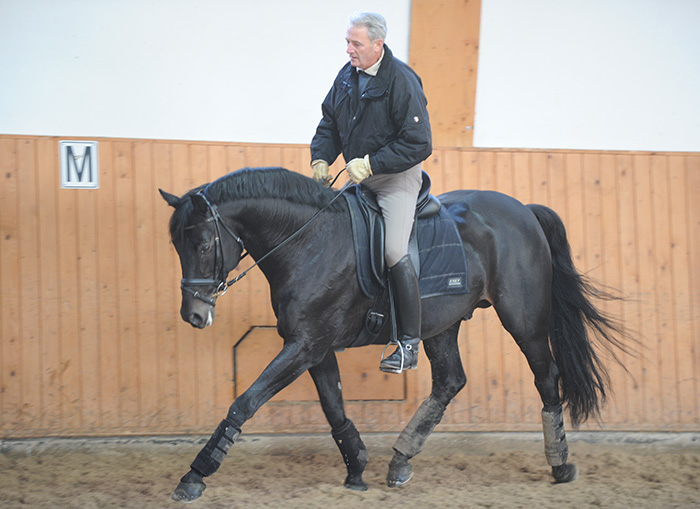
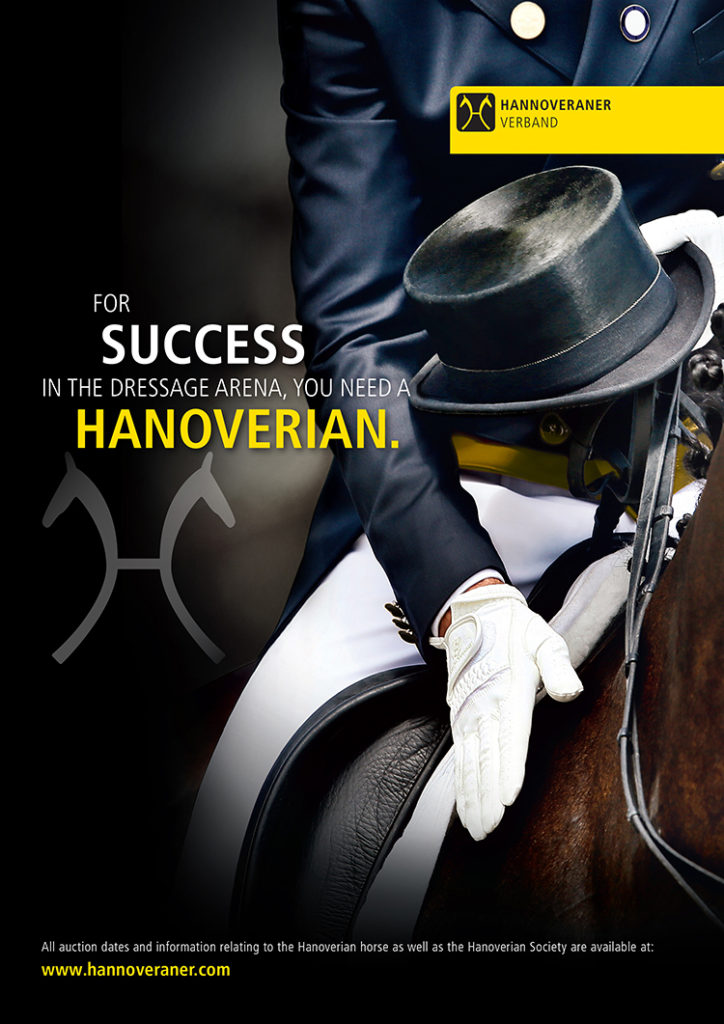
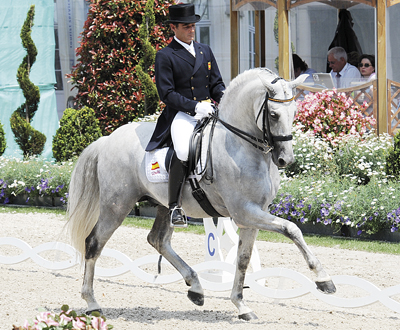
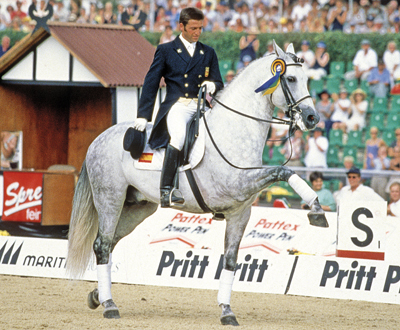
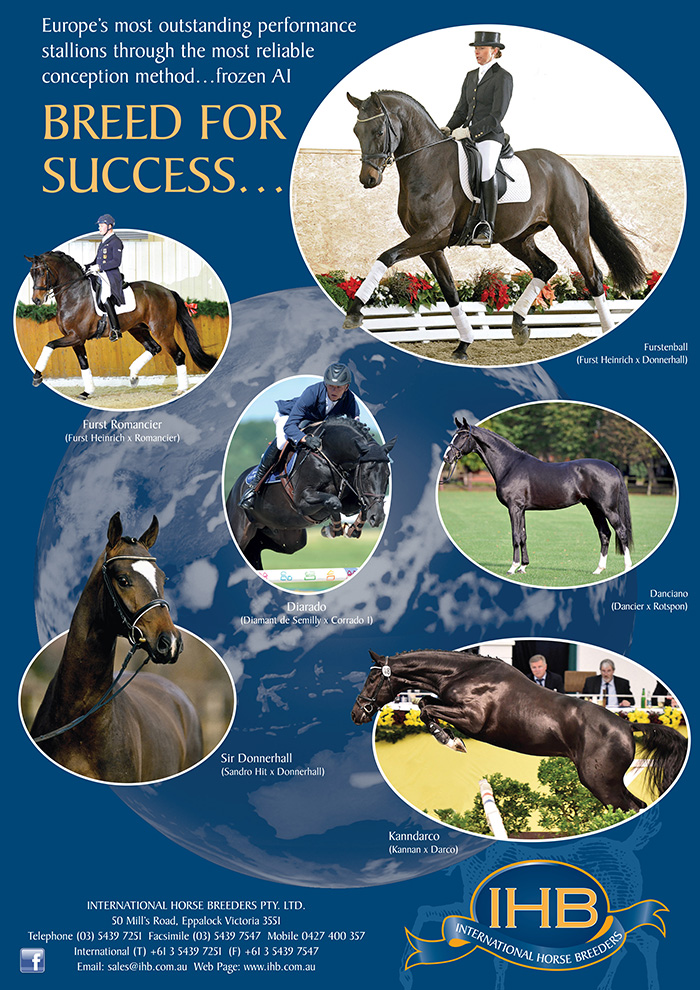
Excellent article!